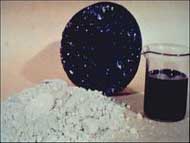|
The National Emission Standards for Hazardous Air Pollutants (NESHAP) regulate how asbestos-containing material is handled during building demolition or renovation(30 CFR 61 Subpart M). NESHAP defines asbestos-containing material (ACM) as any material containing more than one percent asbestos as determined by using polarized light microscopy (PLM). ACM is further characterized as either friable or non-friable. Friable means that a material, when dry, can be crumbled, pulverized, or reduced to powder by hand pressure. NESHAP classifies nonfriable ACM as Category I or Category II nonfriable ACM. These standards also outline when ACM becomes regulated ACM (RACM) and the procedures that must be followed to handle and dispose of these materials.
The Asbestos NESHAP lists asphalt roofing products as materials that may possibly contain asbestos (see discussion of the presence of asbestos in asphalt shingles ). Regulations are provided on the handling of asbestos containing asphalt roofing products during demolition, renovation and disposal. Some guidance is also provided for the recycling of roofing products that contain asbestos. Section 61.143 of the asbestos NESHAP states "no person may construct or maintain a road way with ... asbestos-containing waste material..." In the EPA document, A Guide to Normal Demolition Practices under the Asbestos NESHAP, the following statement is made: "Asbestos-containing roofing material may not be ground up for recycling into other products." Finally, U.S. EPA made specific determinations regarding the use of asbestos containing asphalt shingles on roadways.
U.S. EPA has issued several determination letters which provide interpretive guidance elaborating on the regulatory status of roofing shingles. For an overview, see Common Questions about the NESHAP and A Guide to Normal Demolition Practices under the Asbestos NESHAP. Section 61.150 of the Asbestos NESHAP provides detailed procedures for the collection, processing, packaging and transport of RACM waste material generated.
Facilities processing RACM may also be regulated under OSHA Standard Number 1910.1001 relating to occupational exposures to asbestos in industries covered by the Occupational Safety and Health Act.
The experience of a number of asphalt shingle recyclers shows that while asbestos may be present in asphalt roofing materials such as built-up roofing and mastic, asbestos is not typically encountered in the shingles themselves. For new operations, testing may be required to ensure that this is true for the local waste stream. Testing involves collecting samples and having a laboratory analyze the samples for the asbestos content. Contact your state regulatory official to determine specific state requirements for sample collection and analytical procedures. The typical analytical procedure is Polarized Light Microscopy (PLM).
The National Institute of Standards and Technology maintains a Directory of Accredited Laboratories that conducts asbestos fiber analysis using PLM. The federal asbestos regulations do not provide specific guidance on sampling "loads" of asphalt shingles arriving at a recycling facility, but some guidance may be gathered from the solid waste test methods. See chapter 9 of SW-846, Test Methods for Solid Waste and these ASTM guidelines:
You will need Adobe Acrobat Reader to view Portable Document Format files (PDF).

|
